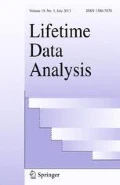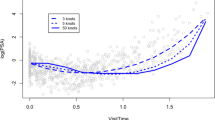Abstract
Multi-state models are models for a process, for example describing a life history of an individual, which at any time occupies one of a few possible states. This can describe several possible events for a single individual, or the dependence between several individuals. The events are the transitions between the states. This class of models allows for an extremely flexible approach that can model almost any kind of longitudinal failure time data. This is particularly relevant for modeling different events, which have an event-related dependence, like occurrence of disease changing the risk of death. It can also model paired data. It is useful for recurrent events, but has limitations. The Markov models stand out as much simpler than other models from a probability point of view, and this simplifies the likelihood evaluation. However, in many cases, the Markov models do not fit satisfactorily, and happily, it is reasonably simple to study non-Markov models, in particular the Markov extension models. This also makes it possible to consider, whether the dependence is of short-term or long-term nature. Applications include the effect of heart transplantation on the mortality and the mortality among Danish twins.
Similar content being viewed by others
References
P. D. Allison, Survival analysis using SAS System. A practical guide, SAS Institute Inc., 1995.
P. K. Andersen and Ø. Borgan, “Counting process models for life history data: A review,” Scandinavian Journal of Statistics vol. 12 pp. 97–158, 1985.
P. K. Andersen, Ø. Borgan, R. D. Gill, and N. Keiding, Statistical models based on counting processes, Springer Verlag, 1993.
D. R. Cox, and H. D. Miller, The theory of stochastic processes, Methuen and Co, 1965.
J. Crowley and M. Hu, “Covariance analysis of heart transplant survival data,” Journal of the American Statistical Association vol. 72 pp. 27–36, 1977.
J. E. Freund, “Abivariate extension of the exponential distribution,” Journal of the American Statistical Association vol. 56 pp. 971–977, 1961.
M. Hauge, “The Danish twin register.” In Prospective Longitudinal Research: An Empirical Basis for the Primary Prevention of Psychosocial Disorders, eds. S. A. Mednick, A. E. Baert and B. P. Bachmann, Oxford: Oxford University Press, pp. 217–221, 1981.
M. Hauge, B. Harvald, M. Fischer, K. Gotlieb-Jensen, N. Juel-Nielsen, I. Raebild, R. Shapiro and T. Videbeck, “The Danish twin register,” Acta Geneticae Medicae et Gemellogogiae vol. 17 pp. 315–331, 1968.
J. M. Hoem, “The statistical theory of demographic rates. A review of current developments (with discussion),” Scandinavian Journal of Statistics vol. 3 pp. 169–185, 1976.
P. Hougaard, Analysis of multivariate survival data, Book manuscript, 1999.
P. Hougaard, B. Harvald and N. V. Holm, “Assessment of dependence in the life times of twins.” In Survival Analysis: State of the Art (eds. J. P. Klein and P.K. Goel), pp. 77–97. Kluwer Academic Publishers, 1992.
P. Hougaard, M.-L. T. Lee and G. A. Whitmore, “Analysis of overdispersed count data by mixtures of Poisson variables and Poisson processes,” Biometrics vol. 53 pp. 1225–1238, 1997.
J. D. Kalbfleisch and R. L Prentice, The statistical analysis of failure time data, John Wiley and Sons, 1980.
R. Kay, “A Markov model for analysing cancer markers and disease states in survival studies,” Biometrics vol. 42 pp. 855–865, 1986.
N. Keiding and P. K. Andersen, “Nonparametric estimation of transition intensities and transition probabilities: a case study of a two-state Markov process,” Applied Statistics vol. 38 pp. 319–329, 1989.
J. P. Klein, N. Keiding and E. A. Copelan, “Plotting summary predictions in multistate survival models: probabilities of relapse and death in remission for bone marrow transplantation patients,” Statistics in Medicine vol. 12 pp. 2315–2332, 1993.
J. P. Klein, N. Keiding and C. Kamby, “Semiparametric Marshall-Olkin models applied to the occurrence of metastases at multiple sites after breast cancer,” Biometrics vol. 45 pp. 1073–1086, 1989.
P. H. Kvam and F. J. Samaniego, “Multivariate life testing in variably scaled environments” Lifetime Data Analysis vol. 3 pp. 337–351, 1997.
J. F. Lawless and K. Thiagarajah, “A point-process model incorporating renewals and time trends, with application to repairable systems” Technometrics vol. 38 pp. 131–138, 1996.
K. M. Leung and R. M. Elashoff, “A three-state disease model with interval-censored data: Estimation and applications to AIDS and cancer” Lifetime Data Analysis vol. 2 pp. 175–194, 1996.
A. W. Marshall and I. Olkin, “A multivariate exponential distribution,” Journal of the American Statistical Association vol. 62 pp. 30–44, 1967.
R. Z. Omar, N. Stallard and J. Whitehead, “A parametric multistate model for the analysis of carcinogenicity experiments” Lifetime Data Analysis vol. 1 pp. 327–346, 1995.
O. Platz, “A Markov model for common-cause failures,” Reliability Engineering vol. 9 pp. 25–31, 1984.
R. L. Prentice, B. J. Williams and A. V. Peterson, “On the regression analysis of multivariate failure time data,” Biometrika vol. 68 pp. 373–379, 1981.
F. Proschan and P. Sullo, “Estimating the parameters of a bivariate exponential distribution in several sampling situations,” In Reliability and Biometry, Siam Philadelphia, 423–440, 1974.
Author information
Authors and Affiliations
Rights and permissions
About this article
Cite this article
Hougaard, P. Multi-state Models: A Review. Lifetime Data Anal 5, 239–264 (1999). https://doi.org/10.1023/A:1009672031531
Issue Date:
DOI: https://doi.org/10.1023/A:1009672031531




